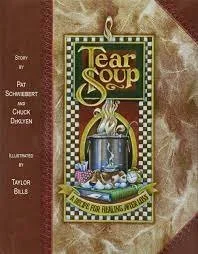By elementary school, children have developed an awareness of death. They’ve seen characters pass away in TV shows and movies, and noticed that plants and animals die in real life, too. None of this makes it any easier, however, when a loved one dies. Death brings up many difficult questions for elementary-aged kids, and reading books about grief together can set the stage for healthy conversations about loss.
We’ve already covered picture books to help children under 5 cope with a loss. Today we’ll take a look at books geared toward slightly older kids. These 5 books can help early elementary schoolers—roughly ages 5 through 8—learn about grief, death, and serious illness.
How Stories Help 5, 6, 7, and 8-Year-Olds Through Grief
Stories and picture books give 6 through 8-year-old children accurate, age-appropriate information about death, which can help reduce anxiety. Death is a big unknown for all of us, but especially for kids. Children who don’t have enough information about death may make assumptions on their own that lead to even more worry, such as wondering whether or not they did something to cause their loved one to die.
Reading a book also helps children talk and think about death without having to share their own personal experiences. It’s easier to talk about a fictional character and their grief. Stories help elementary-aged children understand grief through another person’s perspective, and hopefully realize that the feelings they’re having are normal and healthy, too.
Time spent with a parent or loving adult is one of the most helpful experiences a grieving child can have. 5,6, 7, and 8-year-olds will still need a lot of support from you to understand their grief. Sitting down to read a book together is a wonderful way to comfort your child and let them know its okay to talk about grief.
Finding Meaning in the Life Cycle: The Fall of Freddie the Leaf, by Leo Buscaglia
Recommended age range: 4-8
At first glance, the title and plot of this book might seem a little corny—at least it did to me! The story follows a leaf through the four seasons of the year, from growth in the spring to falling off the tree and dying in the fall. It’s accompanied by nature photography that shows the beauty of each season.
While the book is recommended for kids ages 4-8, I think the length and wordiness of the story might challenge the attention spans of some younger readers. The story also raises some big philosophical questions that might be better suited to older kids, like “What’s our purpose in life?” Finding meaning in life and death is an important part of grieving, and few children’s books talk about it. If your child is starting to ask deeper questions, this book is a gentle way to think about how life and death are both natural parts of life.
One small word of caution: at the very end of the book, there’s one brief mention of death feeling like falling asleep. Younger children may take this literally and worry about falling asleep at night. I’d recommend changing the words when you get to that page!
Talking About Causes of Death: When Dinosaurs Die, by Laurie Krasny Brown and Marc Brown
Recommended age range: 4-8
Death is never easy to talk about, but it can be even harder to broach the subject when a loved one’s cause of death was difficult or sensitive. This heavily illustrated book is divided into panels, like a comic strip. The pictures are expressive, colorful, and full of small details for children to notice and study. The pictures alone can prompt a lot of discussion, but this child-friendly book also shares some hard truths about death.
When Dinosaurs Die offers brief, age-appropriate explanations of death caused by violence, racial prejudice, suicide, and substance abuse. It also helps children understand that while most people live to a very old age, it is sometimes possible for very young children and even babies to die. These specifics may be too much information for families looking for a more general introduction to the subject of death. If your little one has experienced one of these causes of death, however, reading about them in print can be extremely reassuring.
Flip through this book in advance to ensure that the content is right for your child’s needs. It’s okay to pick and choose sections to share. This is one of the books I find myself turning to again and again in my child therapy practice to help children make sense of more difficult grief experiences.
Saying Goodbye After an Illness: Ida, Always by Caron Lewis
Recommended age range: 4-8
Ida Always doesn’t feel like an educational or therapy book—it’s just a good story. Like many of my favorite books for kids, this one teaches by showing, not by telling. Readers meet Ida and Gus, two polar bears at the Central Park Zoo (who really existed!) who are best friends. One day, Ida becomes very sick and can’t get better. Over the course of the book, Ida and Gus grieve and prepare for Ida’s death together.
This book offers a child-friendly explanation of death, as well as a good example of what to expect when someone has a terminal illness. Ida sleeps more often, has good and bad days, and sometimes need a moment alone while she is sick. Gus goes through some very human feelings, too: disbelief, anger, humor, and acceptance are all a part of the story.
Gus—and readers—learn that you can continue a friendship during and after terminal illness, and that you don’t need to see someone in order to stay connected to them.
A Spiritual Look at Death: The Endless Story, by Melissa Kircher
Recommended age range: 5-10
This lesser-known book explores the entire life cycle, from birth to death as well as what might happen after. It’s great for children who are asking deeper questions about what gives life meaning, or where people go after they die. The Endless Story explores many ideas different people and cultures have about the afterlife. The book uses simple, open-minded language and doesn’t comment on whether anyone is right or wrong, which makes it appropriate for kids of all beliefs and backgrounds.
The Endless Story describes the life cycle as something universal—it happens to all of us. It’s a gentle and even beautiful way of looking at life and death that works for kids of all ages, but really lends itself to elementary-aged kids. The author, a professional artist, has added beautiful illustrations throughout that will encourage children to read this book again and again.
A Recipe for Getting Through Grief: Tear Soup, by Pat Schweibert
Recommended age range: 8+
This quirky, longer picture book uses the metaphor of creating a recipe to describe the many layered “ingredients” that make up the grieving process. Because it’s more abstract, it’s best for older kids who can easily tell the difference between fantasy and reality. Amazon recommends this book for kids 8 and up, but I think it could work for slightly younger children who are avid readers, too. It’s a little on the long side, so you may want to break the story up into a few reading sessions.
In fact, many adults who have reviewed this books say it’s been helpful for them, too. The story’s main character goes through many feelings associated with grief, including a few that are harder to talk about, like jealousy and hopelessness. Children and adults can learn about how grief isn’t a linear process, and it’s okay to focus on your grief for a little while and then take a step back when it becomes too intense. Finally, the book stresses the importance of finding supportive people who understand and can share your grief with you.
Help Your Elementary Schooler Cope with Grief Through Art and Play
These picture books are a great start to helping your young child understand grief, death, and loss. However, grief is a lifelong process: it will take more than one story to help your child work through their feelings. Losing a loved one is a huge, overwhelming experience, and it’s okay to take things one step at a time.
If you need ideas for more small steps you and your child can take to process grief, my book may be right for you. A Parent’s Guide to Managing Childhood Grief takes you step by step through activities you can use at home to help your child safely express big feelings, understand their loss, and begin to adjust to a “new normal” after a loved one has died.
All activities are geared toward children ages 5-11. You can pick and choose the ones that seem right for your child. The book is available on Amazon, Barnes & Noble, or at an independent bookstore near you.







